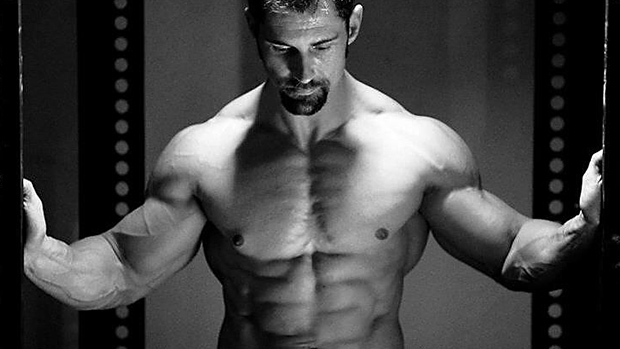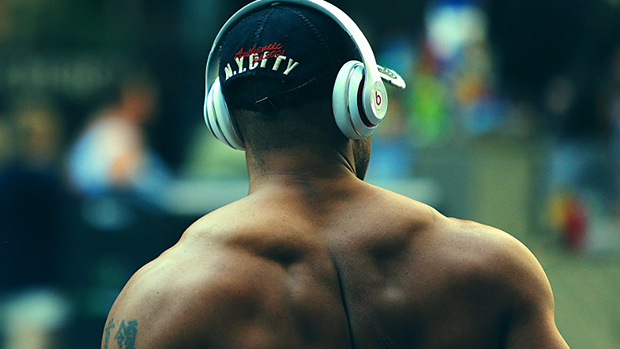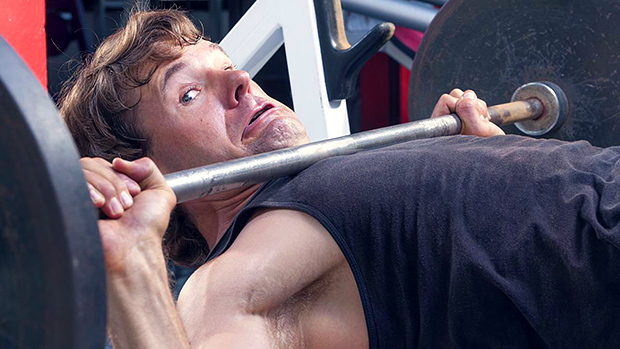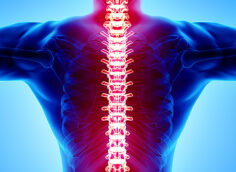It's Not Too Late
If you think you've been lifting hard and eating right, but you're still weak or fat or skinny, it's time to change your approach.
Here are seven things you're probably doing that are exactly why you're not seeing results.
For those of us who don't suckle at the teat of the goddess Steroidia, hypertrophy is not a localized process. It's systemic.
For the most part, given sufficient stimulus, muscle growth happens all over your body instead of in one teeny location. As such, doing work that stresses the whole body - putting a big load on the spine that the entire body must support - will cause more growth in your biceps than working the biceps directly.
To put it another way, doing heavy trap-bar deadlifts will do more to make your arms bigger than doing curls.
A popular rule of thumb in the lifting world states that in order to gain an inch of circumference on your arms, you need to gain about 15 pounds of muscle, and that's pretty much right.
Otherwise you'd see guys walking around who trained nothing but biceps and, as a result, were inverse T-Rex types with huge arms and tiny little bodies. But you don't.
A biceps-specific program will surely add some arm size as long as you're doing everything else right, but the results would generally pale in comparison to what you'd get if you did a program that was biased towards the deadlift or some other big, total body movement.
Likewise, a biceps-specific program would help if you've been doing the big movements all along but need an area-specific catalyst.
Steroids, however, make your whole body ultra-responsive to any kind of mechanical stress. If you're using sufficient quantities of steroids, anything works.
The trouble is, all those body part-specific routines issued through countless bodybuilding mags "written" by bodybuilders did us all a huge disservice.
They convinced many of us to concentrate on curls, kickbacks, shrugs, anterior delt raises, and leg extensions when we should have spent a lot of that time putting big systemic loads on our spine with compound movements.
A few years ago, I visited one of those unsettling body exhibits that featured long dead, desiccated convicts. While I walked through the displays with a perpetual grimace, I couldn't help noticing how every muscle on every body seemed interconnected.

It dawned on me how ridiculous it was to assume that you could actually "isolate" a muscle in an exercise. Any movement you make involves an orchestra of muscles. This is why splitting up workouts by body part can be deleterious to progress.
Your traditional body part split might look like this:
- Monday: Quads, Hamstrings, Calves
- Tuesday: Back
- Wednesday: Chest
- Thursday: Shoulders
- Friday: Triceps, Biceps
But there are a few problems with this layout.
For the whole last half of the week – training chest, then shoulders, and then arms – your workouts involve multiple overlapping muscles, so you're actually training triceps and, to a lesser extent the anterior delts, three days in a row.
Also, if you train hamstrings using Romanian deadlifts, and then do bent-over rows for back the next day, you're actually stressing the hammies two days in a row because bent-over rows involve one long static hamstring hold.
If those examples don't fit the definition of overtraining, I don't know what does.
However, push-pull workouts avoid all that by grouping all the muscles involved in pulling (back, biceps, rear delts, traps, forearms, hamstrings) into one session and all the muscles involved in pushing (chest, triceps, quads, calves, lateral and anterior delts) into another.
By separating the body parts by function, you're also able to hit the gym more often because your muscles stay fresh. If you get especially wild with varying the sets and reps each session, you could potentially hit each muscle group up to three times each week.
You probably think you need to eat a protein meal about an hour before you train and then eat again about an hour after the workout.
Simple enough, but that pre-workout meal raises insulin levels and the nutrients piggyback onto the hormone and are ferried off to muscle cells.
That sounds good in theory, but unfortunately, insulin levels are pretty much back to normal by the time you start your workout, allowing the antagonistic hormone glucagon to start robbing muscles of amino acids so it can convert them to glucose that the muscles need for fuel.
Other catabolic hormones like epinephrine and cortisol have also been released and begin robbing the body of more energy, often from protein itself, and the harder the workout, the greater this breakdown of protein.
Sure, testosterone, GH, and IGF-1 have been summoned, too, but their numbers are too small and their appearance is too transient to fight back. Insulin could fight back, too, but it's in short supply now.
After the draining workout, the lifter goes home and pours a protein shake down his gullet, but by this time his muscle cells are pretty much deaf, dumb, and blind to any rise in insulin.
As a result, insulin can carry amino acids to the doors of the muscle cells and knock as loud as it wants to, but insulin will turn the TV down real low and pretend no one's home. Without a place to go, much of the glucose ends up going straight to fat storage.
And sure, protein won't be stored as fat, but it'll get the bums rush to the liver, which is a kind of purgatory for unused amino acids. The net result of this type of workout nutrition is little to no anabolic stimulus and maybe even some fat storage.
However, we now know how to manipulate all these hormones and nutrients to a much greater degree. The enlightened lifter has a protein and carb drink before his workout, and it's a bit more sophisticated than what was used in the past.
This modern drink contains unique di- and tripeptides that are directly absorbed into the bloodstream, along with a healthy bolus of easily digested functional carbohydrates. Insulin starts to surge, of course, and the glucose and aminos are carried to the muscle cells.
Fifteen minutes prior to the workout, the modern nutrition-savvy lifter ingests another blend of functional carbs and quick-acting protein. This ensures that insulin is still flowing and working at peak capacities. During the workout itself, our enlightened lifter continues to sip on this same protein/carb blend.

By now, during what would normally be the most metabolically devastating part of the workout, his insulin levels are high and the antagonistic hormones like glucagon and the catabolic ones like cortisol and epinephrine are all locked in the basement, afraid to come out.
Instead of being besieged by aggressive hormones, the muscles are in effect being force-fed the right nutrients so anabolic processes can be carried out.
After the workout, our modern lifter fixes himself another small protein drink or "pulse", and since his muscle cells are still sensitive to insulin, the fresh di- and tripeptides are quickly carried off to the still-greedy muscle cells.
The net result of this approach is super-high protein synthesis, low levels of catabolic hormones, and increased fat oxidation.
And, if you were to actually weigh the muscles of this evolved lifter, you'd see that his muscles are actually heavier than if he'd followed the old "solid meal first" approach.
The message should be clear. Practice state-of-the-art workout nutrition.
Sure, it seemed to make sense. You do your aerobic exercise first thing in the morning and since you haven't yet eaten, glycogen levels are low and the body has to resort to burning fatty acids for fuel.
As a result, you can see the fat just melting off you, or so the story goes.
There are two aspects we need to look at. The first is simply... does it work?
Most studies do indeed suggest that you burn more fatty acids in a fasted state, but the numbers are all over the place. One recent study suggests fasted cardio burned about 17% more fatty acids than non-fasted cardio. But let's look at it in terms of actual calories.
If 30 minutes of steady-state, non-fasted cardio burns about 300 calories, and you do that three times a week, you'd burn 900 calories. Stick with that plan for 26 weeks and you'd burn 23,400 calories, which equals roughly 6.6 pounds of fat... over six months.
However, what if we overestimate and assume that doing fasted cardio burns a spectacular 30% more calories, while readily admitting that there isn't a single study that's shown it to be that effective.
Burning 30% more calories would help you burn a measly additional 0.07 pounds per week, which adds up to another 2 pounds of fat lost over that same six month period.
Not too impressive, is it? And that's being overly generous with the numbers, but it's at least something, so we need to look at whether there's any reason we shouldn't do fasted cardio.
For that, we need to look at it from a "muscle health" standpoint. We know that cortisol levels are highest in the morning, and if you don't eat, it stays elevated. If you do fasted cardio in that state, cortisol levels rise even higher, and that's one of the best ways to lose muscle.
Instead, switch to doing morning cardio in a "post-absorptive" state, which is a state where you're not fasted, but neither are you actively digesting food. you can accomplish this by drinking a mixture of di- and tripeptides (such as Mag-10®) that are absorbed pretty much right into the bloodstream with very little active digestion.
That way, you can keep cortisol down and force your body to burn up glycogen and fatty acids.
So yes, technically fasted cardio will burn more fat than non-fasted cardio, but the total number of extra calories burned is pretty anemic. However, fasted cardio will also elevate cortisol levels and burn up precious muscle, so it's counter-productive, at best.
If the squat and the deadlift are the big lower body systemic movements, the loaded pull-up is one of the biggest and baddest upper body systemic movements.

The pull-up will work the lats, the teres major and minor, infraspinatus, rhomboids, levator scapulae, trapezius, deltoids, pectoralis major and minor, the brachialis, brachioradialis, biceps brachii, even the abdominals and triceps brachii.
In short, it builds all the stuff we want built, except the legs, of course. And that's just the standard, bodyweight pull-up. What I'm stressing is the loaded pull-up.
Plenty of people can do an impressive number of simple pull-ups, but the muscle-building is going to come from adding load by wearing a weighted belt, vest, or even holding a dumbbell with your feet.
The increased resistance and relatively-lower rep range bring out even more of the serious muscle-building potential of this overlooked exercise. Cable pulldowns ain't got nothing on loaded pull-ups.
No one actually makes improvements from training. Instead, they make improvements from recovering from training.
Rest and sleep are essential, but too many people take the concept of recovery to an extreme.
Unless you ran an ultra-marathon while carrying an Atlas stone, you don't need to spend your days off by emulating a corpse in a Barcalounger.
Instead, practice active recovery techniques like Prowler pushes, kettlebell swings, sledgehammer work, or even riding a bicycle up some hills.
Weight training involves both eccentric and concentric movements, but it's the eccentric (lowering or negative) movements that can cause damage to the muscle and increase soreness, and it's essentially the eccentric activity that you need to recover from.
The best active recovery exercises are non-eccentric or mostly non-eccentric movements.
As such, you can do them on your "recovery days" to increase overall blood flow, which improves recovery, and burn a few extra calories after a "rest day cheat meal" that would've otherwise been stored as fat, to further your physique-honing progress.
I'm not suggesting you do these movements on every single off day from the gym, but there's no reason you can't do them twice a week and have one day off for complete rest.
For instance:
- Monday: Train
- Tuesday: Train
- Wednesday: Active Recovery
- Thursday: Train
- Friday: Train
- Saturday: Active Recovery
- Sunday: Total Rest
Everyone's been telling you to eat six meals a day, or every 2-3 hours, since the day you got interested in creating a buffitudinous body.
The premise was to keep blood sugar levels "steady" by never allowing yourself to get hungry. The trouble is, there's no evidence to suggest that it works, and there's plenty of evidence that it doesn't. It has to do with insulin.
In normal, healthy people, glucose is taken up by the bloodstream and moved into the cells where it's burned as fuel. This process is mediated by insulin, which is produced by the pancreas after you eat a meal.
However, glucose can build up in the blood if the cells aren't able to utilize it properly, which is a condition called insulin resistance. Type II diabetics are a prime example of this.
They can't adequately handle the amounts of glucose in their blood because they've eaten so much or eaten so poorly that the cells are reluctant to utilize sugar, so the pancreas keeps producing more and more insulin to no avail.
As long as the beta cells of the pancreas are able to throw enough insulin at the cells to overcome the resistance, you're okay; blood glucose can stay in the healthy range.
Over time, though, insulin resistance builds up, and it can lead to pre-diabetes or type II diabetes because the beat up cells can't keep up with the increased need for insulin.
Unfortunately, you may already be teetering on the brink of insulin resistance because you've been keeping insulin levels perpetually elevated with that "6 meal a day" bodybuilding dogma. While your cells were once keenly sensitive to insulin, they've now grown sluggish.
So, if the words "beefy" or "permabulking" describe your physique or if you eat carbs indiscriminately, you're probably at least a bit and insulin resistant.
To change this, consider eating 3, maybe 4, meals a day instead of 6. Have a large breakfast with protein, smart fats, and functional carbohydrates, and the same for lunch. Have a mid-afternoon protein pulse, followed by a dinner of protein and healthy fats.
On workout days, do the same thing, except replace your lunch with your workout nutrition. Also, consider using Indigo-3G® for a host of physique and health benefits.





